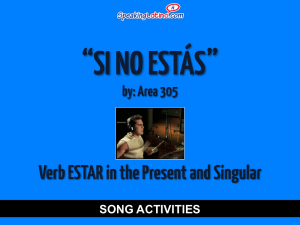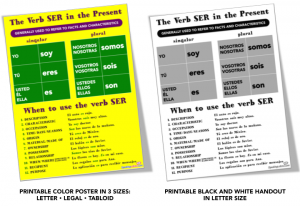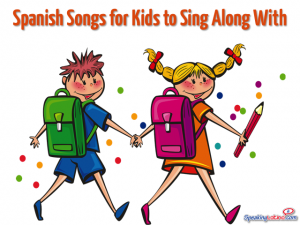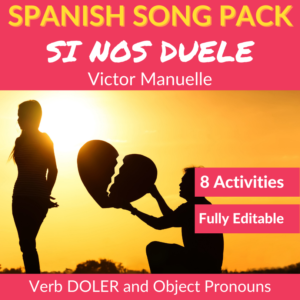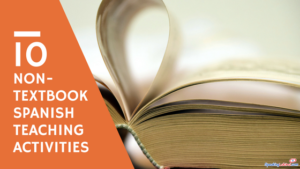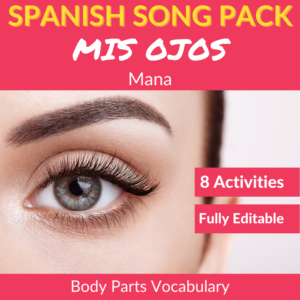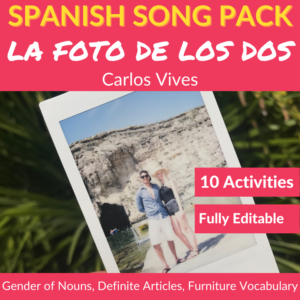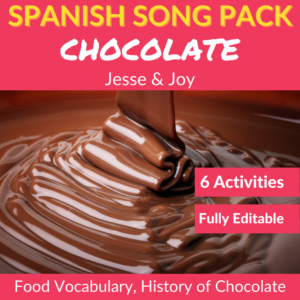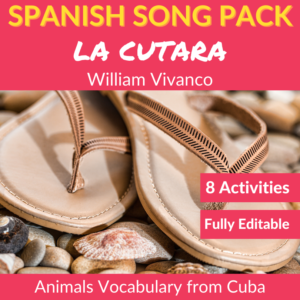Practice the verb ESTAR with the pop song Si no estás. Includes a clozeline activity and exercises to use ESTAR to express emotions, actions and location.
Spanish Verb Conjugation SER: Printable Spanish Poster and Handout
Reinforce the Spanish verb conjugation SER in the present with these printable posters and a handout for your students.
6 Spanish Songs for Kids to Sing Along With
Looking for some great Spanish song for kids? These 7 songs all have great lyrics and a catchy tune that make teaching different Spanish words and concepts simple and fun. Any of these songs would pair nicely with a lesson plan or simple sing-along play time. 6 Spanish Songs for Kids to Sing Along With […]
5 Ideas to Teach Your Kids Spanish During the Summer
These easy activities and games will help you teach your kids Spanish during the summer no matter if you go on a trip or stay at home.
Vendo mi casa cantando by Abraham Sevilla Serrano: Spanish Song to Practice the Rooms of the House and the Verb TENER
With the Spanish song Vendo Mi Casa Cantando your students will practice the rooms of the house vocabulary and the verb TENER in the present tense.
4 Basic Strategies for Teaching Spanish Verbs
Check out these strategies for teaching Spanish verbs that include activity and game ideas for each one.
¿Adónde vas? by Jarabe de Palo: Spanish Song to Practice the Verb IR in the Present
Practice the verb IR in Spanish with the song ¿Adónde vas? by Jarabe de Palo. Includes cloze activity and sentence construction with the form VOY + A.
Spanish Teaching Guide for Substitute Teachers
Use this Spanish teaching guide with ideas and examples to create activities for when a substitute teacher needs to cover your Spanish class.
Si nos duele by Victor Manuelle: Spanish Song to Practice DOLER and Pronouns ME, TE and NOS
With the song Si Nos Duele your students will practice the verb DOLER and the personal pronouns ME, TE and NOS. Includes cloze activities.
When Your Textbook is not the Best Book for Teaching Spanish: 4 Complementary Recommendations
What to do if your textbook is not the best book for teaching Spanish? Check out these books that complement your class: a weekly lesson book, a novel, a verb workbook and vocabulary.
De vacaciones by Estilo Clave: Spanish Song to Introduce Vacations Vocabulary and Reflexive Verbs
Spanish song activities around the song De vacaciones to practice vacation vocabulary and review reflexive verbs. Includes cloze activity.
10 Non-Textbook Spanish Teaching Activities
10 Spanish teaching activities to help students rest from the textbook. With these activities they can practice what they learned during the school year.
Mis ojos by Maná: Spanish Song Activities to Practice Body Parts and Irregular Verbs
Spanish song activities around the song Mis ojos by Maná to practice body parts vocabulary and 7 irregular verbs. Includes cloze activity.
La bilirrubina by Juan Luis Guerra: Spanish Song to Introduce Health Vocabulary
Spanish class activities around La bilirrubina by Juan Luis Guerra to practice or introduce the health vocabulary. Includes cloze activity.
A Twist On These Classic Games to Teach Spanish
A twist on these four popular games to teach Spanish. Includes quick ideas for Memory, Simon Says, White Elephant and Go Fish to use in the classroom.
Y no hago más na’ by El Gran Combo: Spanish Song to Practice Reflexive Verbs
Spanish class activities around the song Y no hago más na’ by El Gran Combo de Puerto Rico to practice reflexive verbs. Includes cloze activity.
Gratitud by Fonseca: Spanish Song to Practice Listening Comprehension and Vocabulary
Spanish class activities around the song Gratitud by Fonseca. Students practice listening comprehension with a cloze activity and also basic vocabulary.
La guagua by Juan Luis Guerra: Spanish Song to Practice the Imperative
Spanish class activities around the song La guagua by Juan Luis Guerra. Includes cloze and imperative verbs worksheet as well as a song interpretation.
Bonito by Jarabe de Palo: Spanish Song to Practice the Present Indicative and Gender Agreement
Spanish class activities with the song Bonito by Jarabe de Palo. Students practice the present indicative, gender agreement and listening comprehension.
List of Spanish Song Activities for Spanish Teachers
Spanish song activities for the classroom. Includes printables, exercises, worksheets and more! Practice listening comprehension, verbs and vocabulary in Spanish.
Gerundio by Los Amigos Invisibles: Spanish Song Activities to Practice Gerunds
Spanish class activities around the song Gerundio by Los Amigos Invisibles. Includes cloze activity and exercises for Spanish gerund conjugations.
Tengo tu Love by Sie7e: Spanish Song Activities to Practice the Verb TENER and Comparisons
Spanish class activities with the song Tengo tu love by Sie7e. With this Spanish song your students can practice the verb TENER and comparisons.
La foto de los dos by Carlos Vives: Spanish Class Activities to Practice the Gender of Nouns and Definite Articles
Spanish class activities around “La foto de los dos” to practice the gender of nouns and definite articles in Spanish. Cloze activity and much more included.
3 Classroom Activities You Can Do With Any Spanish Song
Using popular Spanish songs in class? In addition to cloze activities here are some classroom activity ideas to do with any Spanish song.
Bailando by Enrique Iglesias: Activities to Practice Cognates, Gerunds, Infinitive and Present Verbs
Spanish class activities with the song Bailando by Enrique Iglesias. Activity booklet includes cloze and practice for gerunds, present and infinitive verbs.
TENER QUE: Expressing Obligations and Household Chores Vocabulary Spanish Class Video and Activities
Spanish class activities to practice TENER QUE and household chores vocabulary. Includes a video to introduce the lesson and a PDF booklet with exercises.
Chocolate by Jesse y Joy: Spanish Song Activities to Practice Food Vocabulary, Metaphors and the History of Chocolate
Class activities with Chocolate by Jesse y Joy to practice food, metaphors and learn about the history of chocolate. Clozeline and enrichment videos.
¿Dónde está mi cutara?: Cultural Spanish Song to Learn Animal Names from Cuba
Spanish class activities around the traditional cultural Spanish song ¿Dónde está mi cutara? Students will learn popular Spanish names of animals from Cuba.
Blanca Navidad: Spanish Song Activities to Practice Winter Vocabulary
Spanish song activities to practice Winter vocabulary with the Christmas song in Spanish, White Christmas (Blanca Navidad).
Rodolfo el reno: Spanish Class Activities to Practice the Preterite and Imperfect
Spanish Class Activities with Rudolph, the Red-Nosed Reindeer Christmas song in Spanish (Rodolfo el reno). Students practice the preterite and imperfect.
